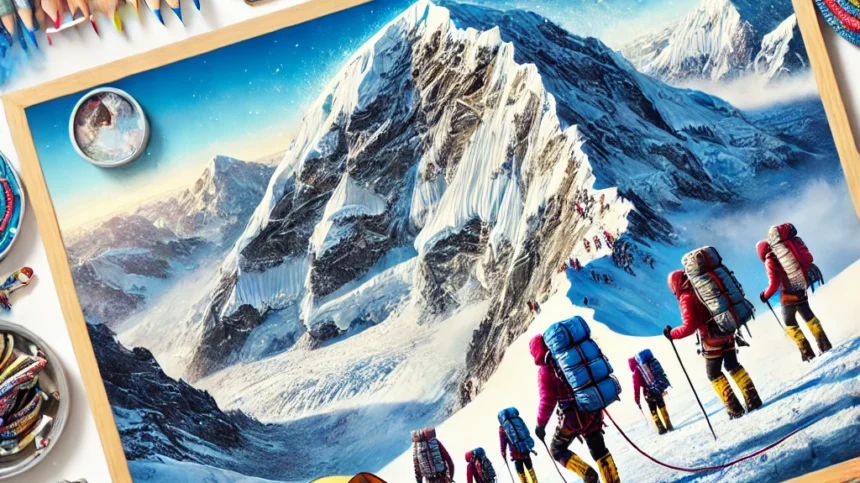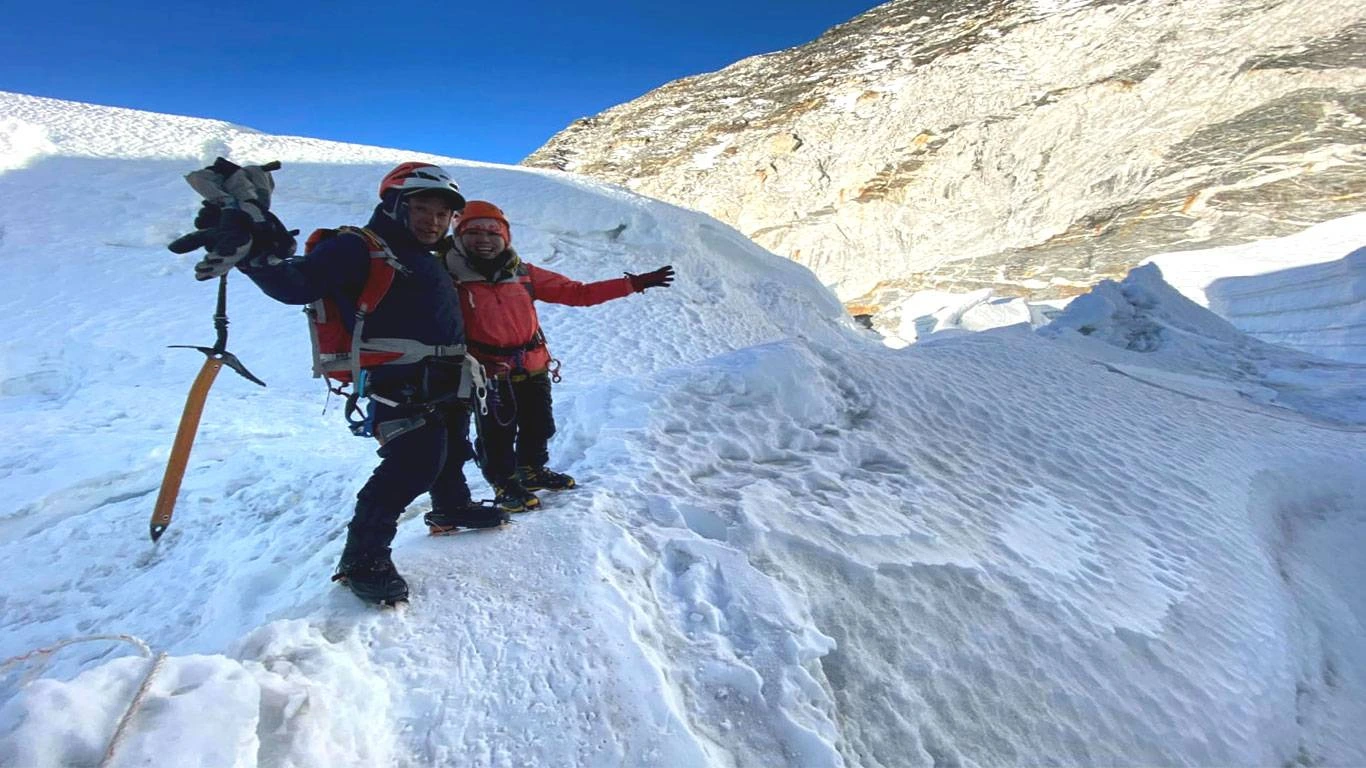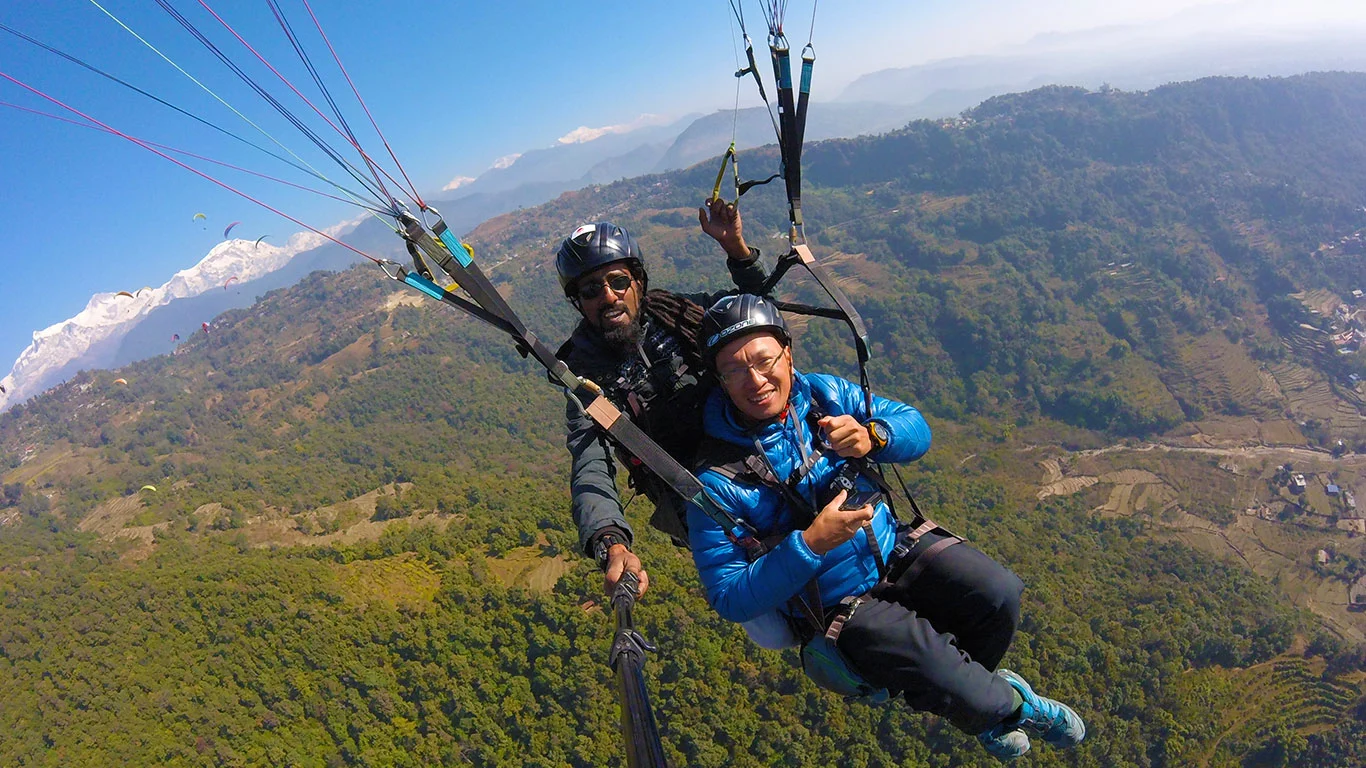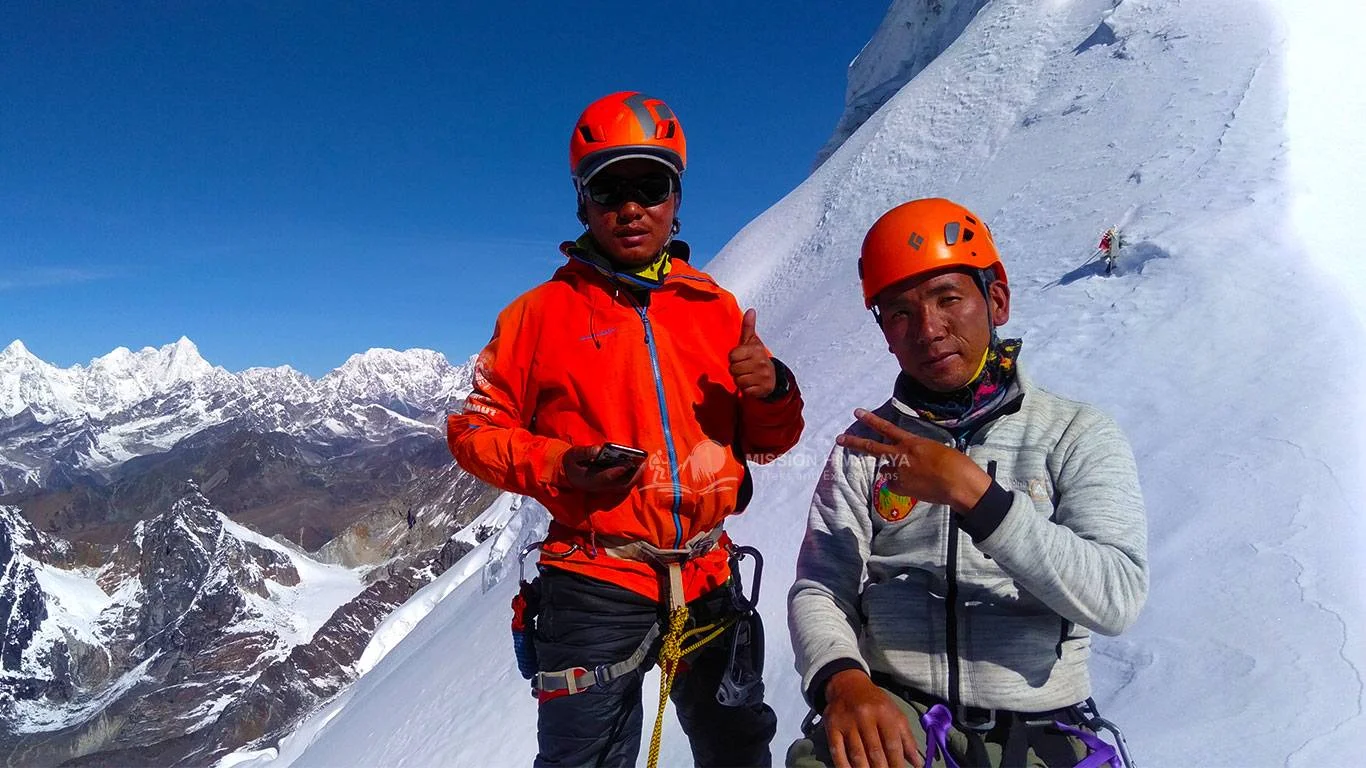Understanding the Expenses Involved in Summiting Lobuche Peak
Tucked in the Everest region, Lobuche Peak is a dream for adventurers and climbers. Its steep ridges, breathtaking views, and sense of achievement make it a favorite for anyone wanting to push their limits in the Himalayas. But climbing Lobuche Peak isn’t just about being fit—it also takes smart money planning. Setting up a good budget is key to making your trip smooth and successful.
This guide will help you understand how much Lobuche Peak climbing cost. It explains where your money will go and how to plan for this exciting journey.
Things That Affect the Cost of Climbing Lobuche Peak
The total cost of your adventure depends on several factors:
- Permits: You’ll need a Lobuche Peak climbing permit and an entry pass for Sagarmatha National Park.
- Guides and Porters: Hiring experienced people helps you stay safe and comfortable.
- Gear and Equipment: From sturdy boots to special climbing tools, having the right stuff is very important.
- Lodging and Food: Teahouses and lodges along the trail offer a cozy place to rest but add to your expenses.
- Transportation: Flights to Lukla, local rides, and emergency travel options all need to be included in your budget.
How Much Does It Cost?
Based on what climbers have shared, here’s what you can expect:
- Total Cost: $2,500–$5,000 per person.
- Trip Duration: Usually lasts 18–22 days.
- Permit Fees:
- Lobuche Peak climbing permit: Around $250 (depends on the season).
- Sagarmatha National Park fee: About $30.
- Khumbu Rural Municipality fee: About $20.
Expert Advice
“Planning your budget is just as important as getting in shape for a climb. A good budget lets you buy the right gear, hire trusted guides, and be ready for emergencies. This makes your climb safer and more enjoyable,” says Dawa Sherpa, a guide with over 20 years of experience.
What Impacts the Cost of Climbing Lobuche Peak?
Your total cost depends on many things, like when you climb and how you set up your trip. Here are the main factors:
Climbing Season
The time of year you climb makes a big difference:
- Peak Season (Spring and Autumn): March to May and September to November are the best times. The weather is nice, and the views are clear, but prices go up because everyone wants to climb during these months.
- Costs increase by 15–25% compared to off-seasons.
- Off-Season (Monsoon and Winter): June to August (monsoon) and December to February (winter) are cheaper. However, you’ll face bad weather and fewer services.
How You Climb
The way you organize your climb affects your budget:
- Fully Guided Trips: Includes guides, porters, and full support. This is the safest and easiest option but also the most expensive, costing $3,000–$5,000.
- Semi-Guided Trips: Includes some guide help and partial support. Costs between $2,000–$3,500.
- Independent Climbs: You do everything yourself. This costs $1,500–$2,500 but is riskier.
Trip Length
Longer trips mean higher costs because:
- Lodging and Food: Every extra day adds to your expenses.
- Guides and Porters: Their pay is calculated per day.
- Permits: You may need to pay more if your trip lasts longer than expected.
For example, a 22-day trip can cost 15–20% more than an 18-day trip.
Level of Comfort: Where You Stay and What You Eat
The kind of comfort you want during your trip can make your costs go up or down:
- Accommodation:
- Teahouses: These are basic lodges with simple facilities. They cost $20–$40 per night.
- Camping: You’ll need extra equipment and staff, which makes it more expensive at $40–$60 per night.
- Dining:
- Basic meals cost $5–$10 each. If you want more choices or fancier meals, the price can go up to $15–$20 per meal.
Gear and Equipment: Should You Rent or Buy?
Deciding to rent or buy your climbing gear can change how much you spend:
- Renting: A good choice if you don’t climb often.
- Cost: Renting basic gear costs about $100–$300.
- Buying: Better for frequent climbers, but it costs more at the start.
- Cost: Buying good-quality gear costs about $500–$1,500.
Expert Advice
“Picking the right climbing style and gear is super important for staying safe and keeping costs reasonable. Fully guided trips give peace of mind, but semi-guided or independent climbs can save money if you have experience,” says Pasang Phurba Lama, a trekking expert in Nepal.
A Detailed Breakdown of Lobuche Peak Expedition Costs
Understanding Where Your Money Goes
Planning a Lobuche Peak climbing trip involves lots of expenses, and knowing how your money will be spent helps you plan better. Here’s a simple breakdown of the costs for this exciting adventure in the Himalayas.
Permits and Fees
You need several permits to climb Lobuche Peak:
- Climbing Permit (from the Nepal Mountaineering Association): The cost depends on the season:
- Spring (March–May): $250 per climber.
- Autumn (September–November): $125 per climber.
- Winter/Summer (December–February and June–August): $70 per climber.
- Sagarmatha National Park Entry Permit: $30 per person.
- Khumbu Pasang Lhamu Rural Municipality Fee: $20 per person.
- TIMS Card (Trekkers’ Information Management System): $20 for solo trekkers and $10 for group trekkers.
Total Permit Costs: $120–$300, depending on the season and group type.
Guide and Porter Costs
Having guides and porters is important for safety and convenience:
- Guide Daily Rates: $30–$40 per day.
- Porter Daily Rates: $20–$30 per day.
- Group Discounts: Larger groups often get lower rates.
For an 18-day expedition:
- Guide Cost: ~$540–$720.
- Porter Cost: ~$360–$540.
Accommodation and Food
Where you stay and what you eat will affect your budget:
- Accommodation:
- Teahouses: $20–$40 per night for simple rooms.
- Camping: $40–$60 per night because of extra gear and staff.
- Food and Drinks:
- Meals cost $5–$15, depending on where you eat and what you order.
- Hot drinks like tea or coffee cost $2–$5 each.
For an 18-day expedition:
- Accommodation Cost: ~$360–$720.
- Food Cost: ~$300–$450.
Gear and Equipment
The cost of climbing gear depends on whether you rent or buy:
- Essential Gear: Includes climbing boots, crampons, harnesses, helmets, sleeping bags, and trekking poles.
- Rental Costs: ~$100–$300.
- Buying Costs: ~$500–$1,500.
Example Gear Costs:
- Climbing Boots: $200–$500.
- Down Jacket: $150–$300.
- Sleeping Bag: $100–$250.
- Harness and Helmet: $50–$150.
Transportation
Getting to and from the mountain involves these costs:
- Flights to Nepal: $800–$1,500 for a round trip, depending on your location.
- Domestic Flights: $160–$200 for a round trip between Kathmandu and Lukla.
- Local Transportation: ~$50–$100 for buses and airport transfers.
Total Transportation Costs: $1,000–$1,800.
Insurance and Medical Costs
- High-altitude climbing requires special insurance for your safety:
- Travel Insurance: Covers things like canceled trips and lost luggage.
- Medical Insurance: Covers altitude sickness and emergency rescues.
- Cost: $100–$200 per trip.
- Helicopter Evacuation: Costs $5,000–$10,000, but it’s usually included in premium insurance plans.
Expert Insight: “Insurance for high-altitude climbs is a must. It’s not just for safety but also for peace of mind,” says Dr. Amanda Green, a travel health expert.
Sample Budget Breakdown
| Category | Estimated Cost (USD) |
| Permits and Fees | $120–$300 |
| Guide and Porter Costs | $900–$1,260 |
| Accommodation and Food | $660–$1,170 |
| Gear and Equipment | $100–$1,500 |
| Transportation | $1,000–$1,800 |
| Insurance and Medical Costs | $100–$200 |
| Total Estimated Cost | $2,880–$6,230 |
This comprehensive breakdown ensures climbers understand every cost associated with Lobuche Peak climbing.
Creating a Realistic Budget for Your Lobuche Peak Climb
Tips for Managing Your Finances Effectively
Planning a Lobuche Peak climbing expedition isn’t just about physical preparation—it also requires meticulous financial planning. A well-thought-out budget can help you avoid unnecessary expenses and fully enjoy your adventure.
Creating a Realistic Budget
Before starting on your climb, it’s essential to create a detailed budget that accounts for all possible expenses:
- Draft a Budget Spreadsheet:
-
- Break down costs into categories: permits, guides/porters, accommodation, food, transportation, gear, and insurance.
- Use a spreadsheet to organize and track these expenses.
Sample Budget Template:
| Category | Estimated Cost (USD) |
| Permits and Fees | $120–$300 |
| Guide and Porter Costs | $900–$1,260 |
| Accommodation and Food | $660–$1,170 |
| Gear and Equipment | $100–$1,500 |
| Transportation | $1,000–$1,800 |
| Insurance and Medical Costs | $100–$200 |
| Total Estimated Cost | $2,880–$6,230 |
- Track Expenses During the Trip:
- Use a mobile app or a small notebook to log daily expenses.
- Review your spending periodically to ensure you’re staying within your budget.
Tips to Save Money
Even if your budget is tight, you can save money without missing out on the fun. Here are some simple tips to cut costs:
Travel During the Off-Season
- Traveling in late autumn or early spring (called shoulder seasons) often means cheaper permits and places to stay.
- You can save about 20–30% on your total costs this way.
Get Group Discounts
- If you travel with at least 3 friends, many trekking agencies will give you discounts.
- For a group of 4, you could save $100–$200 per person.
Pack Light
- Only take the things you really need. This means fewer luggage fees and cheaper porter costs.
Cook Simple Meals
- Tea houses offer meals, but bringing your own snacks like instant noodles, oatmeal, or other easy foods can save you $5–$10 per day.
Bargain with Local Vendors
- Don’t be shy to negotiate prices for transport, souvenirs, or other services. You could save a lot by doing this!
Interesting Facts and Numbers
- Seasonal Savings
- Permits for Lobuche Peak in spring cost $250, but in winter they are only $70. That’s a $180 difference!
- Group Discounts
-
Booking guides and porters as a group can lower costs by about 10–15%.
Expert Advice
“Making a detailed budget before your trip helps you avoid stress. Always add 10–15% extra for unexpected expenses,” says James Morton, an experienced traveler and financial expert.
By following these tips and keeping track of your spending, you can enjoy an amazing Lobuche Peak adventure without breaking the bank.
Don’t Forget These Important Costs
A Checklist for Must-Have Expenses
Planning your Lobuche Peak climb needs careful budgeting. Missing an important cost could cause stress or problems during your trip. Use this checklist to ensure you’re ready:
Permits and Fees
You need the right permits to climb. These fees help protect the environment and support local communities:
- Khumbu Pasang Lhamu Rural Municipality Fee: $20–$30
- Sagarmatha National Park Permit: $30 (for foreigners)
- Lobuche Peak Climbing Permit:
- Spring: $250
- Autumn: $125
- Winter/Summer: $70
- TIMS Card (Trekkers’ Information Management System): $10–$20
- Total Permit Costs: $150–$330 (depending on the season).
Tip: Always carry paper copies of your permits. Officials may check them at different points.
Gear and Equipment
Having the right gear is important for both safety and success. Depending on what you already own, you may need to rent or buy:
Essential Gear Checklist
- Climbing Boots: $200–$500
- Down Jacket: $150–$300
- Sleeping Bag (good for -20°C): $100–$200
- Crampons: $50–$150
- Harness: $40–$100
- Ice Axe: $50–$150
- Trekking Poles: $30–$100
- Helmet: $50–$100
Estimated Gear Costs: $500–$1,500 (rentals can reduce costs).
Guide and Porter Costs
Hiring guides and porters is a smart way to stay safe and enjoy your trek. Here’s what to expect:
Cost Estimates:
- Guide: $25–$40 per day.
- Porter: $20–$30 per day.
Example: For a 12-day trek, hiring a guide and porter could cost between $540 and $840.
Tip: Make sure your guide and porter are paid fairly and have proper gear for the trip.
Accommodation and Food
The cost of where you stay and what you eat depends on your choice of tea houses or camping.
Accommodation:
- Tea Houses: $5–$20 per night.
- Camping: $10–$30 per night (this includes setting up the tent and staff costs).
Food:
- Meals at tea houses cost about $5–$10 each.
- Daily food costs range from $20–$40.
Estimated Total:
- For a 12-day trek, you might spend $300–$800 on accommodation and food.
Transportation
Getting to Lobuche Peak involves traveling internationally and within Nepal.
- International Flights: $700–$1,500 (round trip).
- Domestic Flights: From Kathmandu to Lukla, flights cost $160–$200 per person (one way).
- Local Transfers: Buses, taxis, or jeeps will add another $50–$100.
Total Transportation Costs: Expect to spend between $1,000 and $1,800.
Insurance and Medical Expenses
It’s very important to have insurance for high-altitude treks.
- Travel Insurance: $100–$200.
- Make sure it includes emergency helicopter evacuations up to 6,500 meters.
Tip: Always check that your insurance covers climbing and high-altitude activities.
Contingency Fund
You never know when extra costs will come up, so having a backup fund is smart.
- Recommended Amount: Save an extra 10–15% of your total budget, which is about $300–$500.
Why You Need This: This money can help if unexpected things happen, like bad weather delays, extra supplies, or emergency medical care. Without this fund, surprise costs could ruin your trip.
Statistical Data
- Average Daily Costs: ~$80–$150 (all-inclusive).
- Sample Budget Breakdown:
| Category | Estimated Cost (USD) |
| Permits and Fees | $150–$330 |
| Guide and Porter Costs | $540–$840 |
| Accommodation and Food | $300–$800 |
| Gear and Equipment | $500–$1,500 |
| Transportation | $1,000–$1,800 |
| Insurance and Medical Costs | $100–$200 |
| Contingency Fund | $300–$500 |
| Total Estimated Cost | $2,890–$5,970 |
Expert Advice
“A good budget helps you stay ready for surprises on your climb. Always plan for extra costs—it’s better to have more money than not enough,” says Chhumbi Gurung, an experienced expedition leader.
By planning for all the important expenses, you’ll be ready to take on Lobuche Peak with confidence and peace of mind.
Staying on Track with Your Finances While Climbing
Practical Tips for Avoiding Overspending
Climbing Lobuche Peak is exciting, but managing your money well means you can focus more on the adventure and less on your budget. Here are some practical tips to help you stay on track.
Packing Light and Efficient
Why It Matters: Packing light can help you save money on porter fees and avoid extra luggage costs.
- Porter Weight Limits: Most porters carry up to 30 kg (66 lbs) for two climbers. Extra weight costs around $10–$20 per kg.
- Efficiency Tips:
- Choose gear that can be used for more than one purpose.
- Don’t overpack toiletries—many can be bought locally.
- If you’re in a group, share things like tents or cooking supplies.
Statistical Insight: Cutting 5 kg from your luggage can save up to $50 on porter fees over a 12-day trek.
Avoiding Unnecessary Expenses
Impulse Purchases: At higher altitudes, souvenirs and extra items can really add up.
- Costly Items: Things like snacks, bottled water, and extra gear become much more expensive as you go higher.
- For example, a bottle of water in Kathmandu costs about $0.50, but it can cost $4 at Lobuche.
Strategies:
- Bring a reusable water bottle and purification tablets to avoid buying bottled water.
- Limit purchases to things you really need—buy items in Kathmandu where prices are cheaper.
Budgeting for Unexpected Costs
Be Prepared: Sometimes, unexpected expenses like medical emergencies or gear problems happen.
- Recommended Contingency Fund: Save 10–15% of your total budget (~$300–$500).
- Expense Tracking: Use an app or notebook to track what you spend each day to stay on budget.
Real-Life Example: One climber had to replace broken crampons mid-expedition, which cost $100 more because they were harder to find at higher altitudes.
Seeking Local Advice
Why It’s Valuable: Local guides and porters know the best budget-friendly places for food, accommodation, and supplies.
Examples:
- Guides might suggest affordable tea houses with tasty meals.
- Porters can point you to places where supplies are sold at fair prices.
Tip: Build a good relationship with your team. They can give you useful tips and save you money.
Statistical Data
- Average Luggage Weight: Porters carry around 15 kg per climber. Cutting your luggage by 5 kg can save you about $50–$100.
- Cost Escalation: The cost of food and water can go up by as much as 300% the higher you climb.
Expert Opinion
“Managing your money during a trek is all about being prepared and disciplined. Always account for local price differences and have a contingency fund—it’s better to have it and not need it than to be stuck without it,” says Amanda Louis, a budget travel expert with experience trekking in the Himalayas.
A Final Word on Lobuche Peak Climbing Costs
Starting on Your Lobuche Peak Adventure
As you get ready for the exciting journey to the top of Lobuche Peak, it’s important to balance your excitement with smart planning. A good budget helps make sure everything goes smoothly, so you can enjoy the experience without worrying about unexpected costs.
Key Takeaways:
- Cost Factors: The total cost of your Lobuche Peak climb depends on things like the season, how you plan to climb, how long you’ll stay, where you stay, what gear you need, and your travel expenses.
- Detailed Breakdown: Knowing the main expenses—like permits, guides, food, lodging, and insurance—will help you make a realistic budget.
- Budget Tips: Packing light, not buying unnecessary items, and looking for group discounts are smart ways to save money while still enjoying your adventure.
Importance of Planning and Budgeting
Careful planning is key to having a successful climb of Lobuche Peak. By saving for unexpected expenses and finding cost-effective options, you can make your journey safer and more fun.
Prioritize Safety and Responsible Travel
While sticking to a budget is important, your safety and the environment should always come first. Hiring experienced guides, getting the right insurance, and following eco-friendly practices are essential parts of your trip.
Final Encouragement
Climbing Lobuche Peak isn’t just about reaching the top. It’s a life-changing adventure through the amazing Himalayas. The stunning views, personal victories, and rich culture will leave you with unforgettable memories. With smart planning, a clear budget, and a brave heart, you’re ready to make your Lobuche Peak climb a truly special journey.
“The mountains are calling, and you must go”—so pack your bags, aim high, and let your adventure begin!
This wraps up the guide on Lobuche Peak climbing costs.
Birendra Duwadi by profession a trekking and tourist guide and an enterpreur whose passion is trekking in the himalayas start Mission Himalaya Treks in 2015 with a new vision to introduce Nepal Himlayas to the world. his vision is explore and documentation new trekking routes . Birendra leads Mission Himalaya, a small company that change the qualities of trekking in Nepal.











